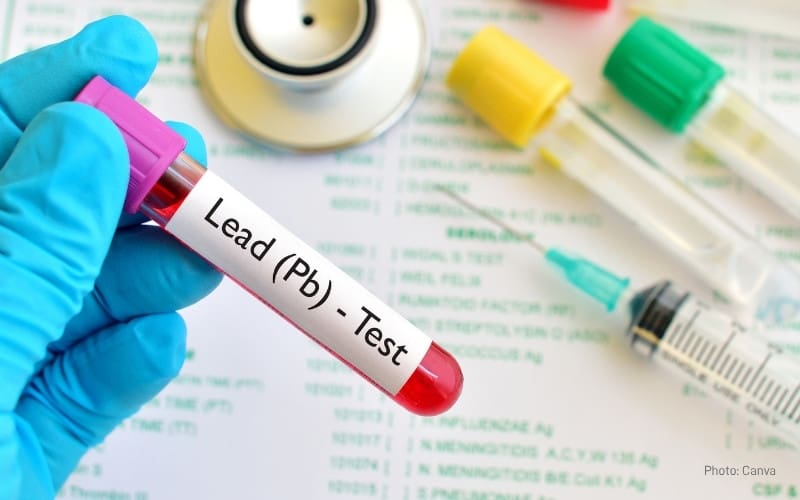
Taking action today to remove lead from our homes is key to making our communities safer for our families and children. Photo: Canva.
Most of us want the same things for our families – a healthy home and a future where children can grow up free from harm. That future shouldn’t be a luxury – or depend on luck. Yet across New England and beyond, lead poisoning remains a silent, persistent threat – especially for young children.
Lead is a potent neurotoxin. Even small amounts can cause irreparable harm to a child’s brain, nervous system, and development – and there is no safe level of lead exposure.
The danger is real – but so is the solution. Childhood lead poisoning is 100% preventable. The main sources of lead exposure are well known: lead paint, contaminated soil, and old plumbing can quietly expose families without any visible signs of danger. In some cases, lead can also show up in ceramics, spices, or household products – items families use and trust.
No one should have to worry that the walls of their home, the water from their tap, or the dishes on their table could put their health at risk. We have the tools, expertise, and responsibility to keep lead out of our homes and communities for good.
Here are five things you need to know about lead poisoning – and how we can finally stop this threat.
1. Lead Has Been Around for Centuries
Lead is a naturally occurring metal that has been used for thousands of years. The ancient Romans used lead in cooking pots and as a sweetener in wine – practices now believed to have caused widespread health problems linked to lead exposure in those communities.


Over time, lead’s durability and resistance to corrosion made it a favored material in plumbing, ceramics, paints, gasoline, and even cosmetics. In the U.S., lead was an integral component in house paint and gasoline. Only in the late 1970s, as the effects of lead poisoning became impossible to ignore, did the federal government begin restricting its use in consumer products.
But here’s the catch: Those bans applied to new uses and materials. They did not remove lead from existing buildings, pipes, and infrastructure. As a result, the risk of lead exposure continues to pose a serious threat today.
2. Lead Is Banned, But Only in New Products
In the U.S., lead is now prohibited in new paint, plumbing, and fuel. But banning new lead use does not make existing lead disappear.

In New England, nearly half of the region’s homes were built before 1978 – the year when the federal lead-paint ban took effect. That means millions of families are still living in buildings where lead lingers in the walls, windowsills, and woodwork. When this paint chips, peels, or turns to dust – as it inevitably does – families are exposed to lead particles.
Many older homes also rely on lead service lines and plumbing fixtures that can leach lead into drinking water as it flows through. In other cases, lead pipes and solder joints slowly release particles over time, contaminating the water that families use every day.
Lead dust and paint chips can also settle in soil near older buildings or along roads that once carried vehicles powered with lead-based gasoline.
Nationwide, over 590,000 young children in the U.S. currently have elevated blood lead levels. Many of them grow up in communities that have endured decades of underinvestment – places full of families who continue to fight for safer and healthier homes. Despite their efforts to improve aging housing and demand better enforcement of housing and health safety laws, the systems meant to protect them have often fallen short, leaving children exposed to preventable harm.
In New Hampshire alone, more than 1,100 children were diagnosed with lead poisoning in a single year – a staggering 42% increase from the previous year.
That’s not just alarming. It’s unacceptable.
3. Lead Exposure Comes from More Places Than You Might Think
You may already know that lead paint and old plumbing are common sources of lead exposure. But lead poisoning can also come from unexpected sources, including:
- Ground spices: Recent research has found lead in common spices, such as cinnamon and turmeric – including products sold by U.S. brands. In one study, nearly a third of tested spices had unsafe levels of lead. Contamination can occur in several ways, ranging from worn-out metal grinders to polluted soil or inadequate storage conditions. And because the U.S. doesn’t require routine lead testing for spices, these risks often go undetected.
- Ceramic dishware: Lead can leach from ceramic dishes and mugs – especially older or handmade pieces. This isn’t just a problem with imported items – many vintage or decorative items sold in the U.S. were manufactured before modern safety standards existed. And there’s no strict federal requirement to label or test every item for lead, meaning these risks often go unnoticed in thrift stores, markets, and even kitchens today.
- Soil near older buildings: Soil can absorb lead from chipping exterior paint, past industrial emissions, or the historic use of leaded gasoline. That dust can be tracked indoors on shoes, settle on garden produce, or expose children through simple contact during play.

In short, you don’t have to live in a visibly deteriorating home to face risk.
4. The Technology to Prevent Lead Poisoning Exists
We already have the tools to eliminate lead hazards. Lead paint can be safely removed. Lead pipes can be replaced. Soil can be remediated. Homes can be tested and made lead-safe during renovations. Landlords and tenants can be educated.
So, if we know how to fix this, why are so many children still vulnerable to lead poisoning?
Some states have failed to pass laws preventing lead exposure. In other states, landlords aren’t required to inspect or disclose lead hazards.
At the federal level, progress has slowed down recently. In 2024, the Biden administration committed to replacing every lead pipe in the country’s drinking water within 10 years. But under the Trump administration, the agency responsible for leading this effort, the EPA, has faced budget cuts and understaffing. Those changes have threatened this initiative to remove lead from our drinking water.
These cuts also impacted state efforts. In Massachusetts, more than $50 million in federal funding intended for lead service line work has been delayed since March 2025.
Our state and federal governments absolutely can – and should – address lead poisoning. The question is whether they’re willing to make the safety of our children and the health of our communities a real priority.
5. A Lead-Free Future Starts with Local Action
Lead poisoning is a public health emergency. But it’s also a solvable one – and one path forward is action at the local level.

In Manchester, New Hampshire, the Board of Mayor and Aldermen in 2023 established the Lead Exposure Prevention Commission to coordinate local strategy. The commission’s charge is to identify lead hazard reduction measures and prevent families from being exposed to lead in their homes. The commission includes local officials and advocates, including Arnold Mikolo, one of CLF’s Environmental Justice Advocates.
Meanwhile, in Chelsea, Massachusetts, lead-laden paint chips from maintenance on the Tobin Bridge have landed in nearby yards. MassDOT contractors are vacuuming up debris and installing shielding netting to prevent further fallout. But the community is organizing to ensure the cleanup is thorough and transparent.
These examples show what’s possible when communities step up. Lead poisoning is preventable, even when state and federal government efforts fall short.
Stop Lead Poisoning: Time for Action
CLF is taking on the fight against lead poisoning from all angles. We’re working directly with communities to better understand their local ordinances and develop stronger protections that reflect the needs of residents. And we’re pushing for stronger laws, safer housing, and funding that ensures no child grows up in a home that puts their health in danger.
You don’t need to be a public health expert to help eliminate lead in your community. Here’s how you can make a difference:
- If you are a parent, have your children tested for lead. Early detection of elevated blood lead levels can make a significant difference in preventing irreversible damage to a child’s health and development.
- Contact your legislators. Urge them to pass stronger laws for lead prevention in homes, schools, and consumer products.
- Ask questions. If you rent, ask your landlord whether the property has been tested for lead. Disclosure is required for homes built before 1978.
- If you own a pre-1978 home, have it inspected. Follow lead-safe practices during any renovations or repairs.
- Push for funding. Support local and state investments in lead remediation, especially in communities most at risk.
Lead has shaped our world for centuries – but that doesn’t mean it has to shape our future. Let’s make this the century we leave lead behind.



